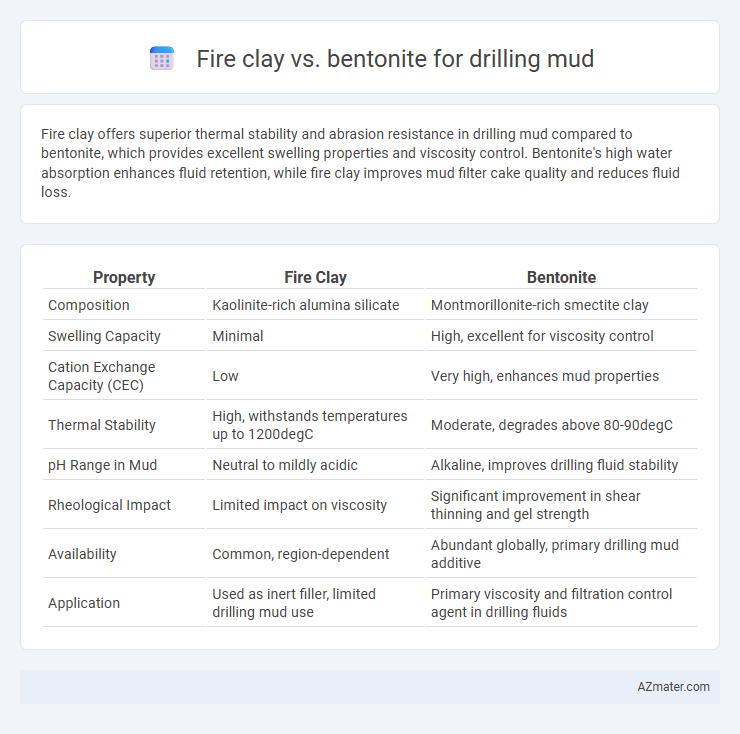Fire clay offers superior thermal stability and abrasion resistance in drilling mud compared to bentonite, which provides excellent swelling properties and viscosity control. Bentonite's high water absorption enhances fluid retention, while fire clay improves mud filter cake quality and reduces fluid loss.
Table of Comparison
| Property | Fire Clay | Bentonite |
|---|---|---|
| Composition | Kaolinite-rich alumina silicate | Montmorillonite-rich smectite clay |
| Swelling Capacity | Minimal | High, excellent for viscosity control |
| Cation Exchange Capacity (CEC) | Low | Very high, enhances mud properties |
| Thermal Stability | High, withstands temperatures up to 1200degC | Moderate, degrades above 80-90degC |
| pH Range in Mud | Neutral to mildly acidic | Alkaline, improves drilling fluid stability |
| Rheological Impact | Limited impact on viscosity | Significant improvement in shear thinning and gel strength |
| Availability | Common, region-dependent | Abundant globally, primary drilling mud additive |
| Application | Used as inert filler, limited drilling mud use | Primary viscosity and filtration control agent in drilling fluids |
Introduction to Drilling Mud Compositions
Drilling mud compositions primarily consist of water, clay minerals, and various additives that enhance drilling efficiency and stability. Fire clay is valued for its high refractory properties and ability to improve mud viscosity and thermal stability during drilling operations. Bentonite, rich in montmorillonite, is widely used for its excellent swelling capacity and thixotropic behavior, which aids in lubricating the drill bit and stabilizing boreholes.
What is Fire Clay?
Fire clay is a type of refractory clay known for its high alumina content and excellent heat resistance, making it ideal in drilling mud for maintaining viscosity and stability at elevated temperatures. It enhances the mud's ability to suspend cuttings and prevent fluid loss, improving overall drilling performance. Unlike bentonite, which swells and forms a gel-like consistency, fire clay offers greater structural integrity in high-temperature drilling conditions.
Understanding Bentonite in Drilling Fluids
Bentonite is a key component in drilling mud due to its exceptional swelling properties and high viscosity, which enhance borehole stability and cuttings suspension. Unlike fire clay, bentonite consists primarily of montmorillonite, enabling superior water absorption and gel formation, critical for effective drilling fluid performance. Its natural ionic exchange capacity improves lubrication and reduces fluid loss, optimizing drilling efficiency in various geological formations.
Key Properties: Fire Clay vs. Bentonite
Fire clay exhibits high refractoriness and low plasticity, making it less swellable and more resistant to chemical degradation in drilling mud applications. Bentonite, primarily composed of montmorillonite, offers superior swelling capacity, excellent thixotropic properties, and high cation exchange capacity, enhancing the viscosity and stability of drilling fluids. The choice between fire clay and bentonite depends on the required mud properties such as filtration control, rheology, and thermal stability for specific drilling conditions.
Performance Comparison in Drilling Operations
Fire clay exhibits excellent thermal stability and fine particle size distribution, enhancing borehole stability and reducing fluid loss in drilling mud formulations. Bentonite offers superior swelling properties and rheological control, improving cuttings suspension and viscosity management during drilling operations. Performance comparison emphasizes fire clay's strength in high-temperature environments, while bentonite excels in maintaining lubricity and fluid consistency under varied downhole conditions.
Environmental Impact: Fire Clay vs. Bentonite
Fire clay and bentonite differ significantly in environmental impact when used in drilling mud. Bentonite, primarily composed of montmorillonite, has a high swelling capacity that improves mud filtration and wellbore stability but can lead to challenges in disposal due to its fine particle size and potential to cause soil salinization. Fire clay, with its lower swelling properties and more inert mineral composition, tends to have a reduced risk of contaminating surrounding ecosystems, making it a more environmentally favorable option in drilling operations.
Cost Analysis and Availability
Fire clay offers moderate cost advantages and is readily available in many regions, making it a cost-effective option for drilling mud formulations. Bentonite, while typically more expensive, provides superior swelling properties and viscosity control, which can reduce overall operational costs in challenging drilling environments. Availability of bentonite is often limited to specific geographic locations, impacting transportation costs and supply consistency compared to the more commonly sourced fire clay.
Mixing and Handling Characteristics
Fire clay exhibits high plasticity and good water retention, making it easy to mix uniformly into drilling mud with minimal clumping, while providing excellent viscosity control for stable drilling operations. Bentonite, composed mainly of montmorillonite, swells significantly when hydrated, requiring careful hydration time and continuous agitation during mixing to prevent lump formation and ensure consistent gel strength. Handling bentonite demands more attention due to its sensitivity to salt and pH changes, whereas fire clay's inert nature offers easier storage and handling in varying field conditions.
Best Use Cases for Each Material
Fire clay offers superior thermal stability and high plasticity, making it ideal for drilling mud in high-temperature geothermal wells. Bentonite excels in water absorption and swelling capacity, which provides excellent viscosity and suspension properties, perfect for conventional oil and gas drilling operations. Selecting fire clay is optimal for environments requiring heat resistance, while bentonite is preferred for its effective lubrication and filtration control in typical drilling fluids.
Conclusion: Choosing the Optimal Clay for Drilling Mud
Fire clay offers superior thermal stability and abrasion resistance, making it ideal for high-temperature drilling conditions, while bentonite excels in viscosity control and fluid loss reduction due to its swelling properties. Bentonite is generally preferred for its cost-effectiveness and thixotropic behavior, providing efficient wellbore stability and cuttings suspension. Selecting the optimal clay depends on the specific drilling environment, required thermal resistance, and fluid performance criteria essential for minimizing operational risks.

Infographic: Fire clay vs Bentonite for Drilling mud
 azmater.com
azmater.com